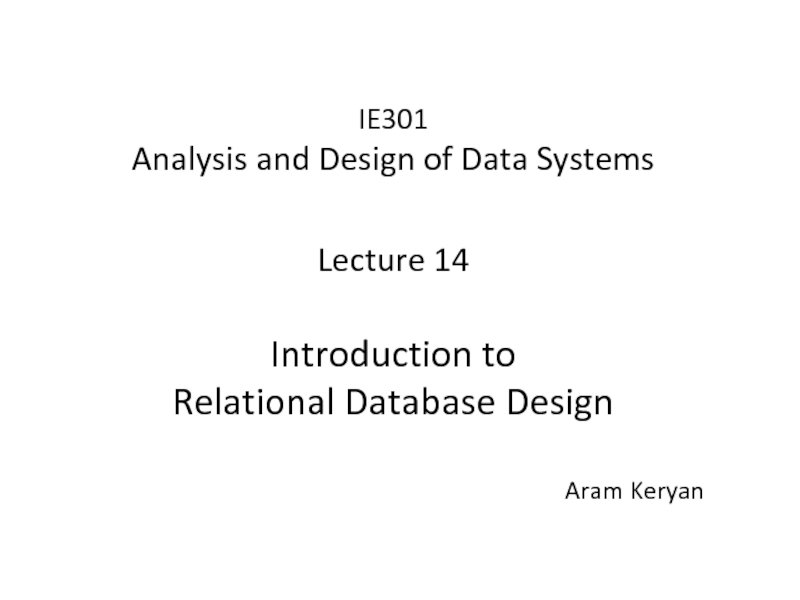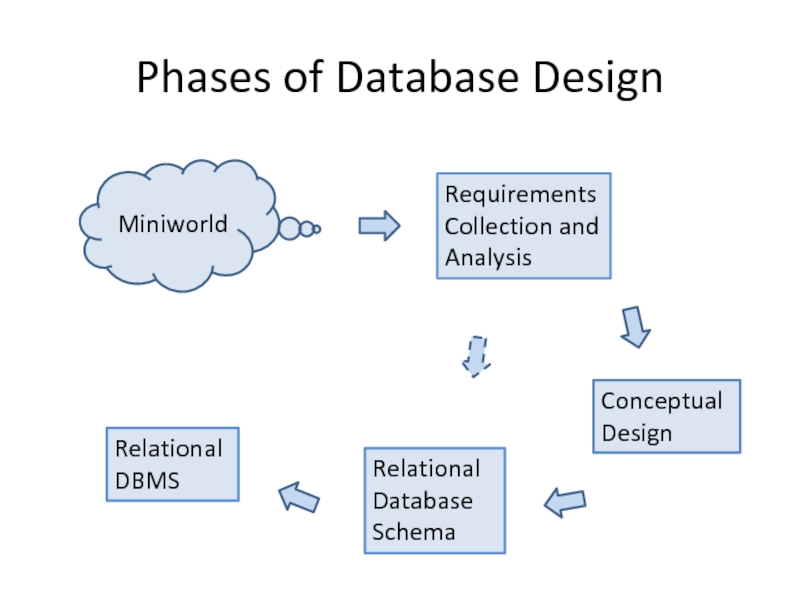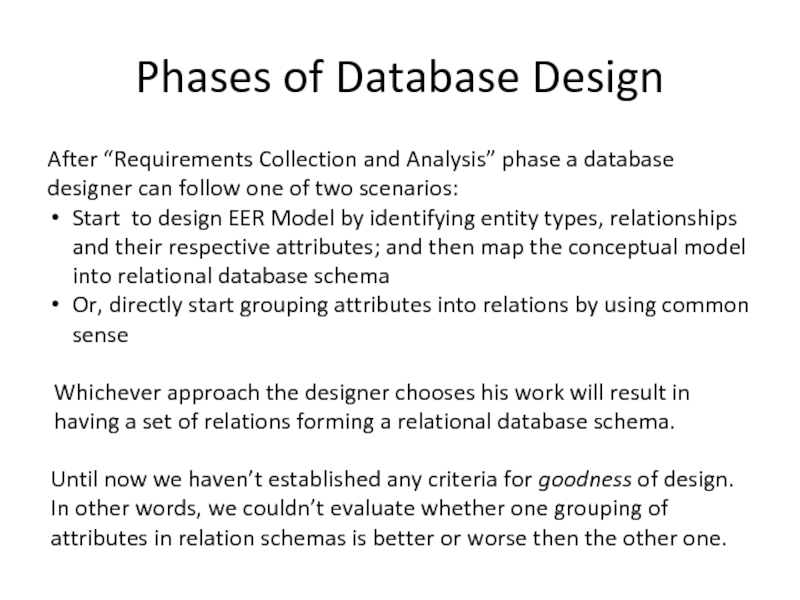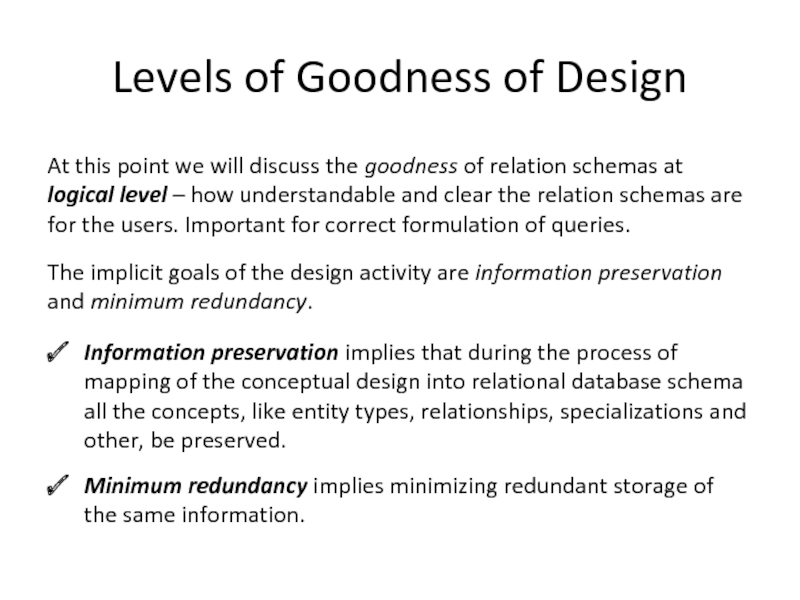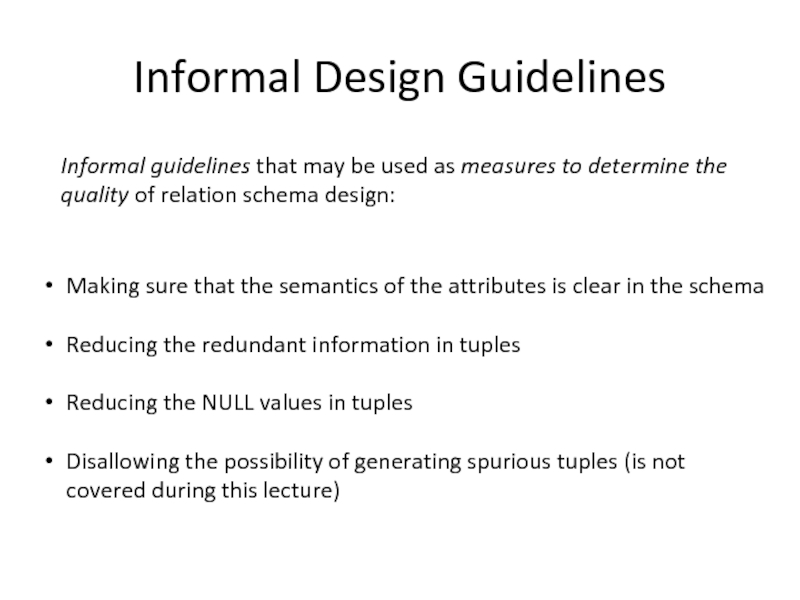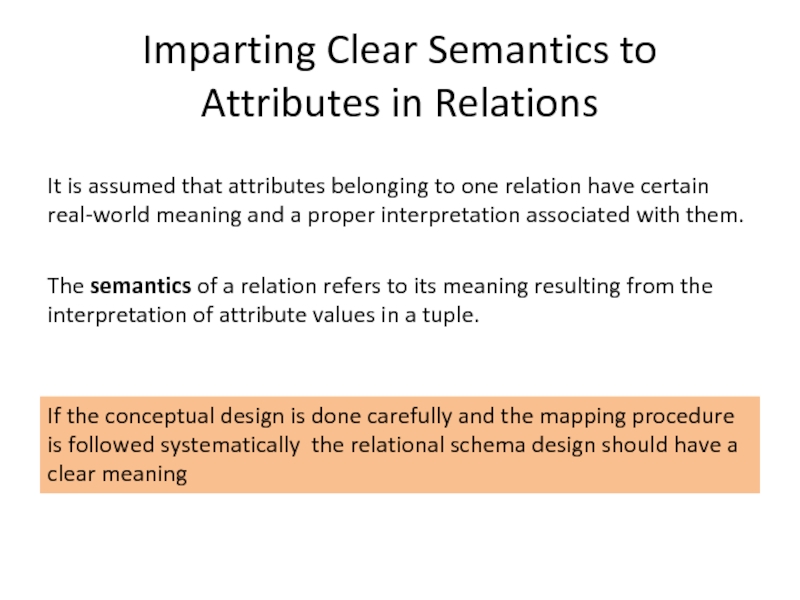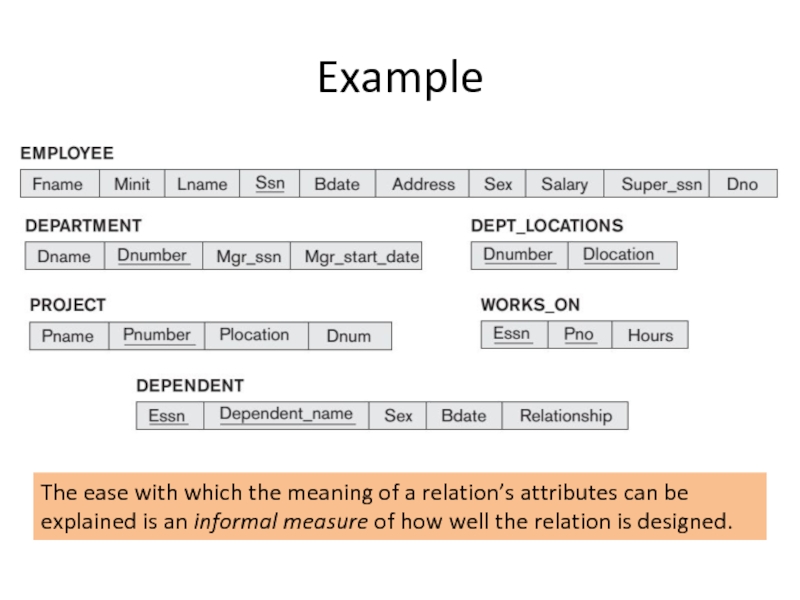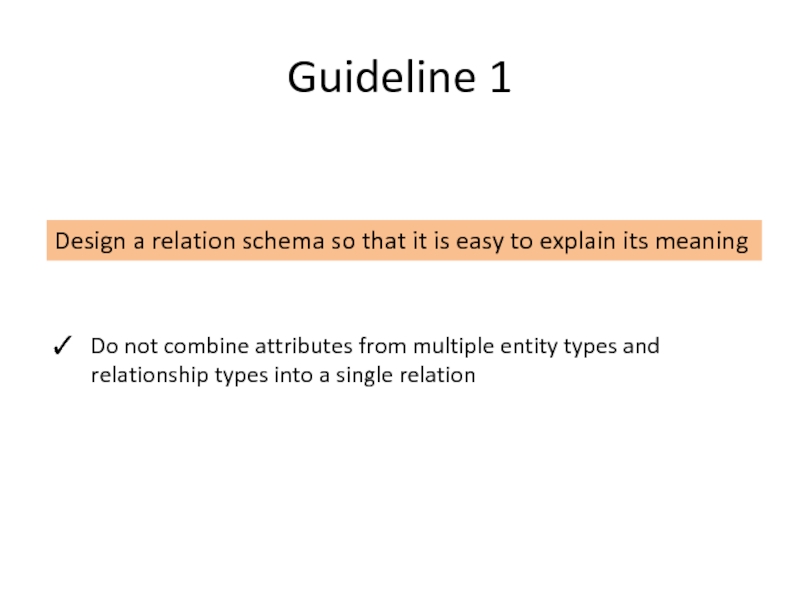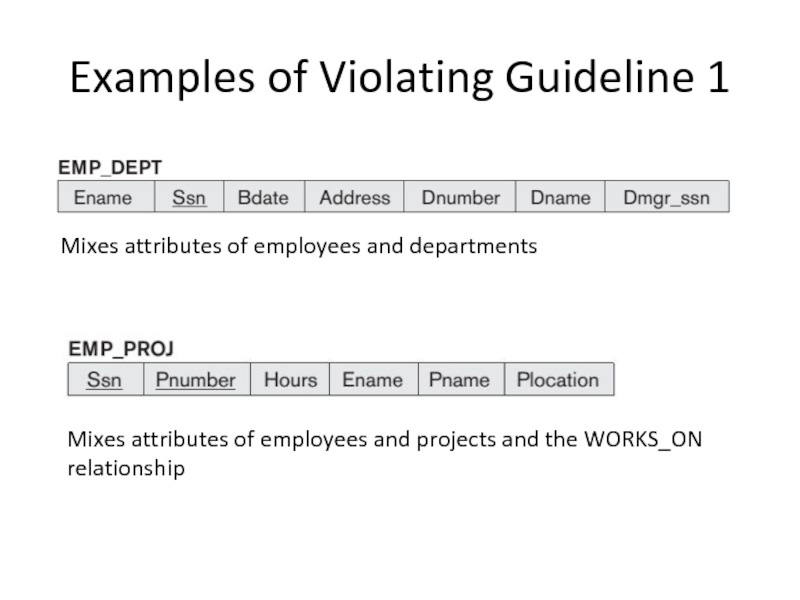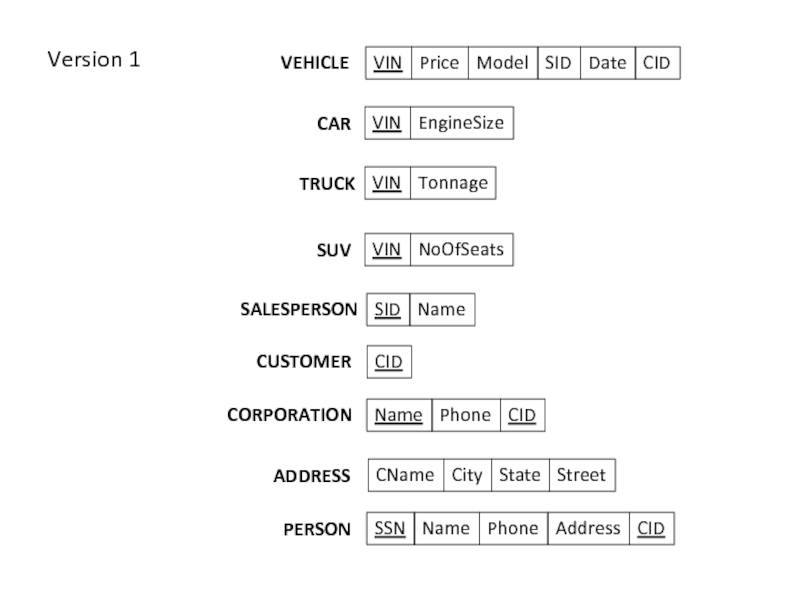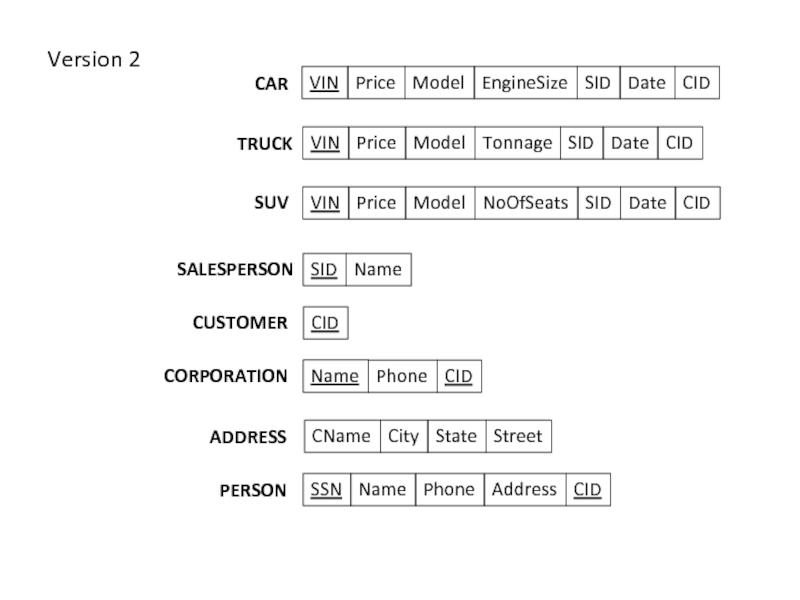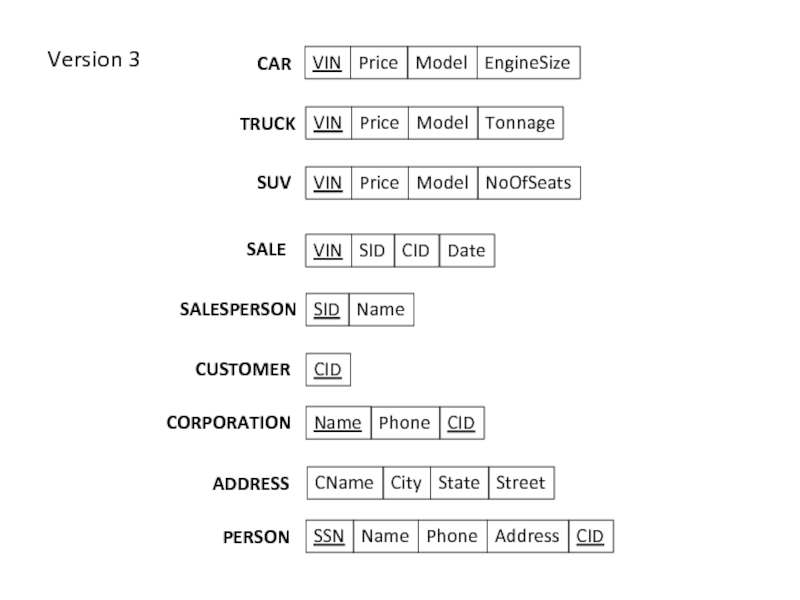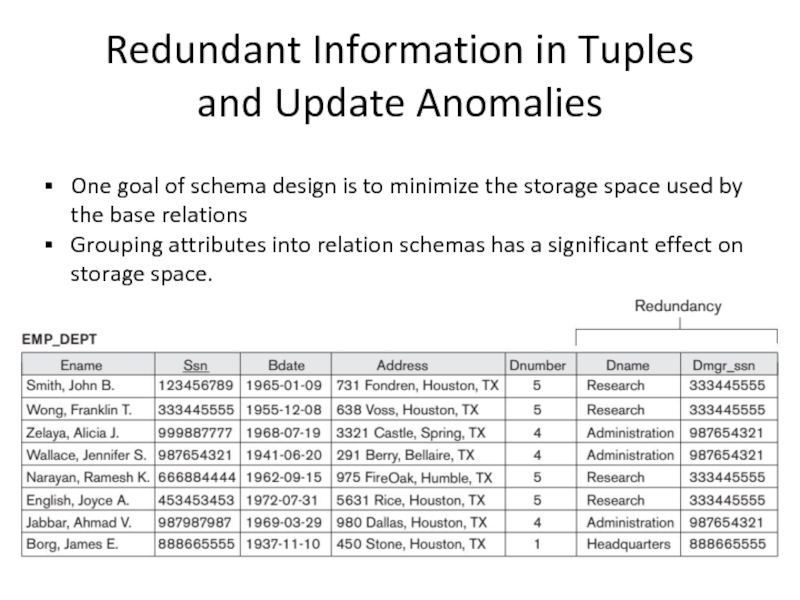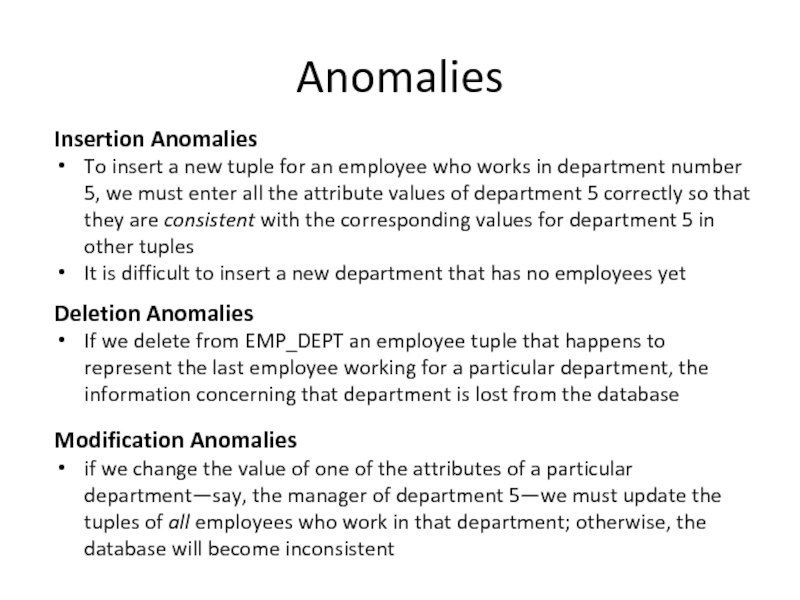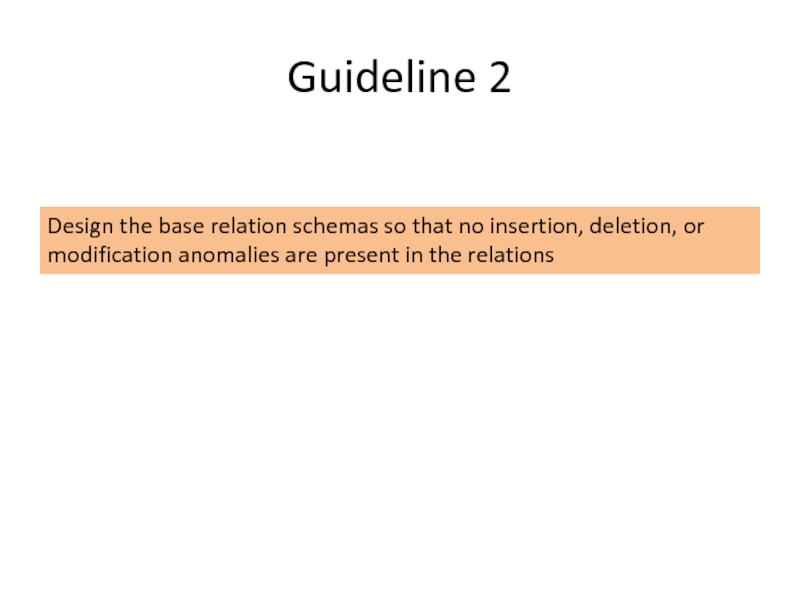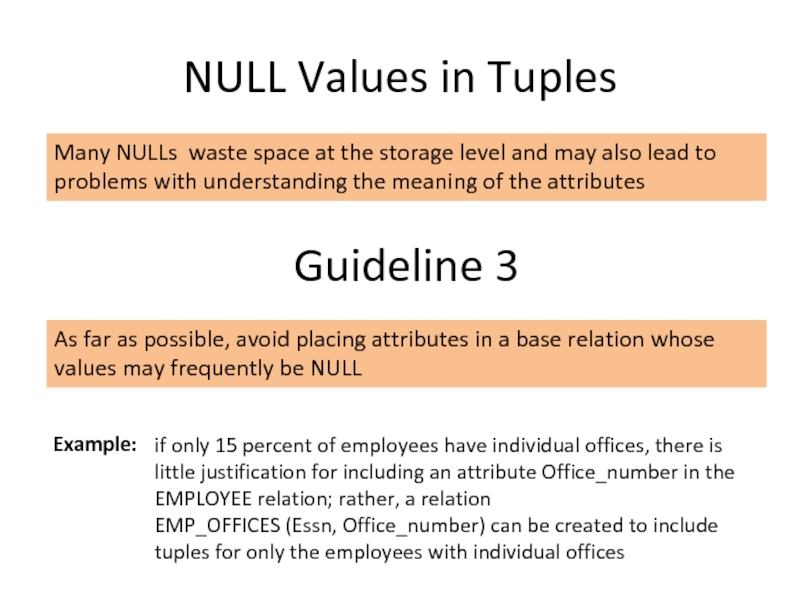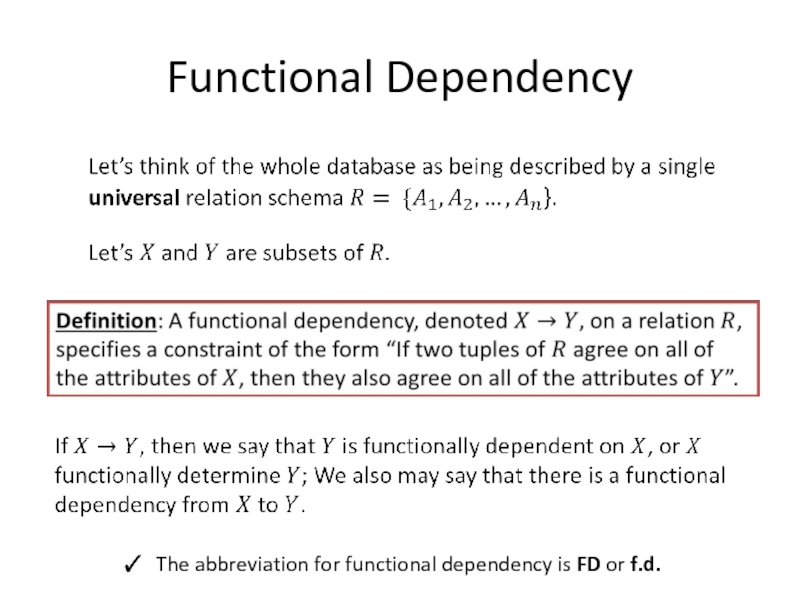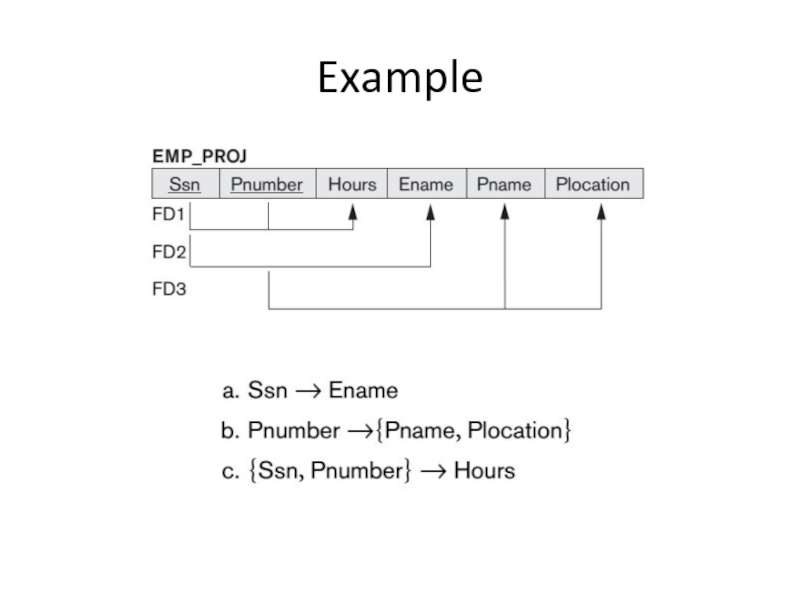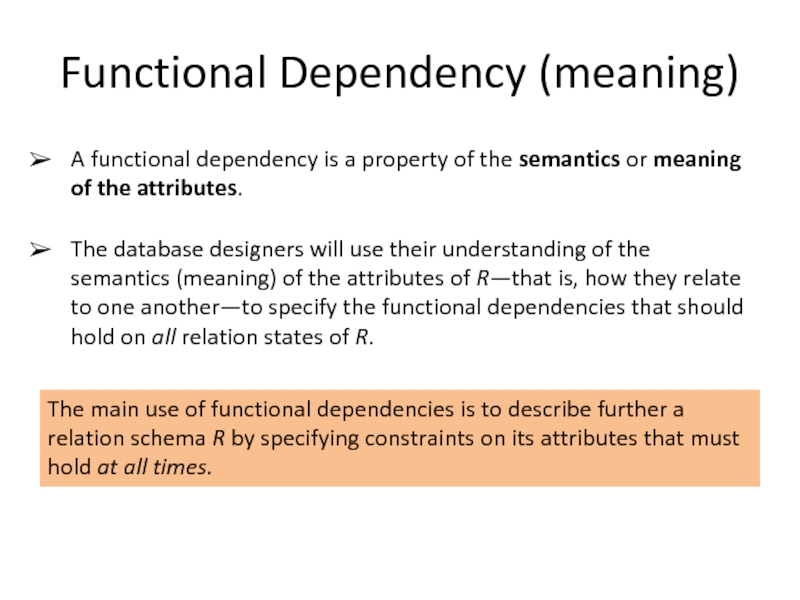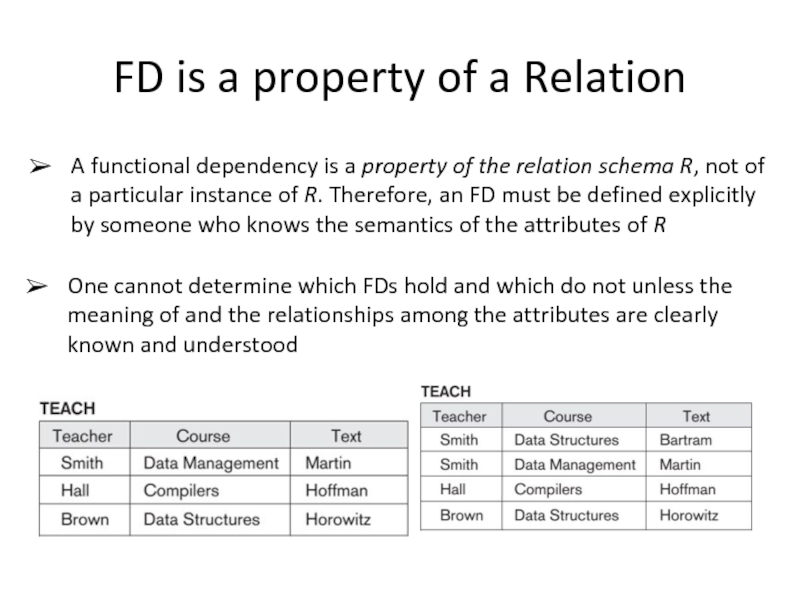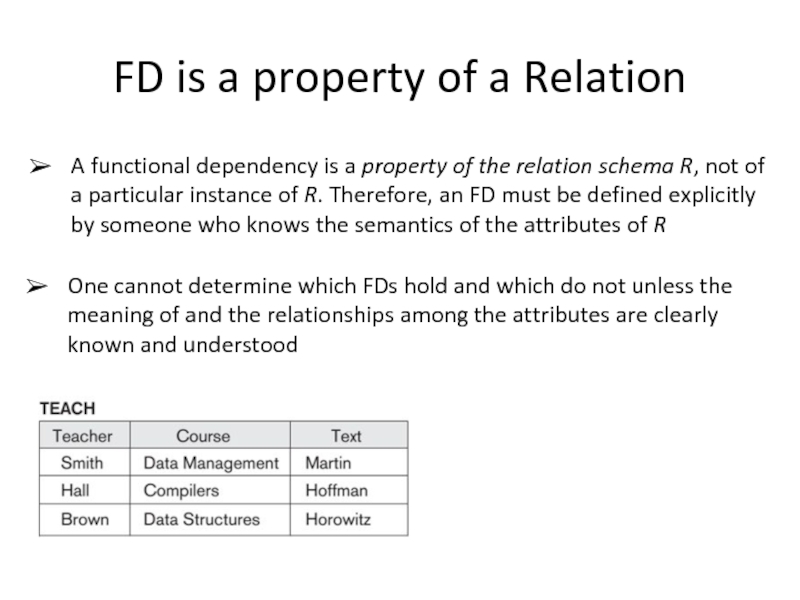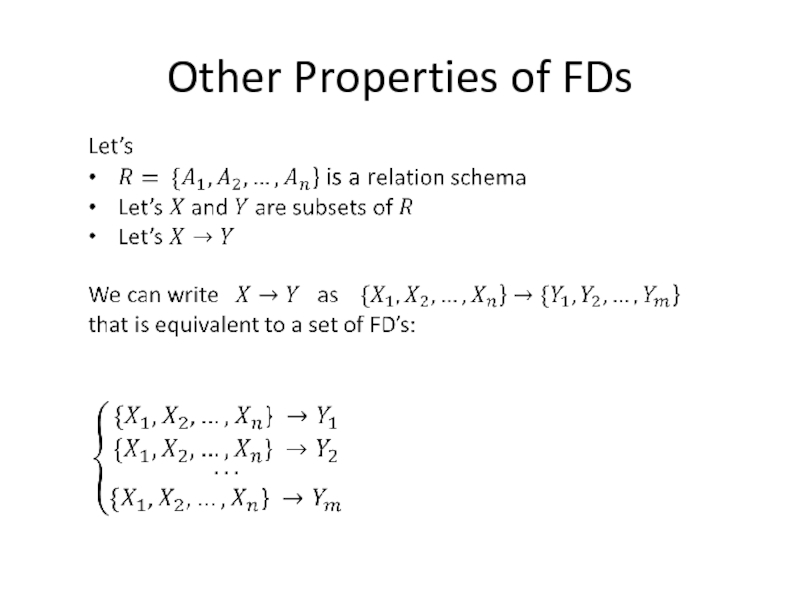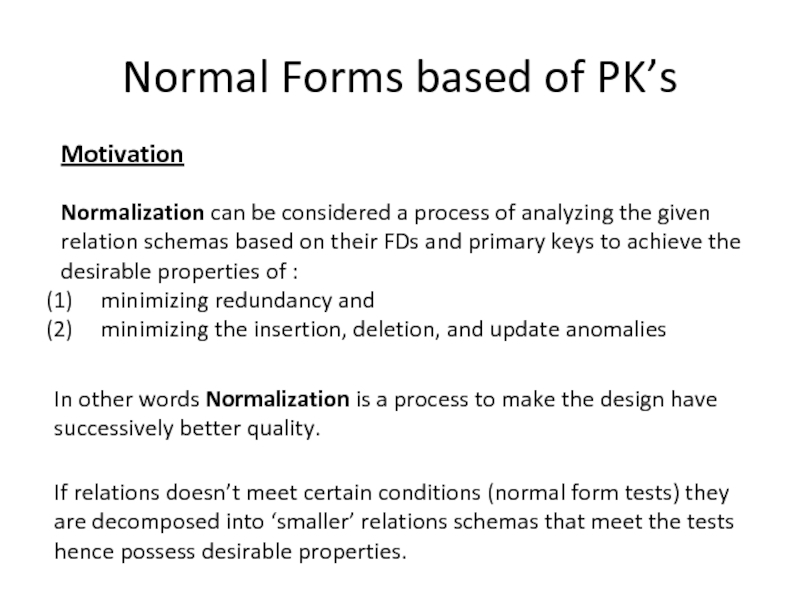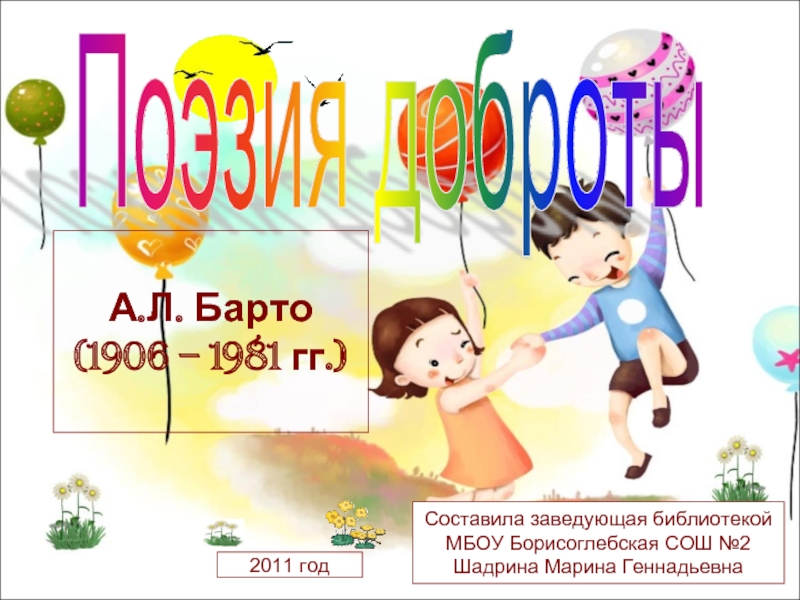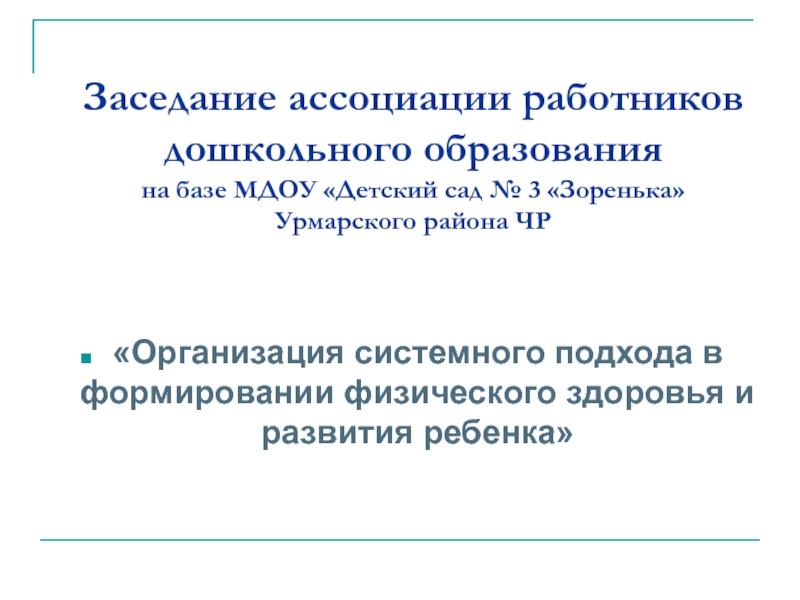- Главная
- Разное
- Дизайн
- Бизнес и предпринимательство
- Аналитика
- Образование
- Развлечения
- Красота и здоровье
- Финансы
- Государство
- Путешествия
- Спорт
- Недвижимость
- Армия
- Графика
- Культурология
- Еда и кулинария
- Лингвистика
- Английский язык
- Астрономия
- Алгебра
- Биология
- География
- Детские презентации
- Информатика
- История
- Литература
- Маркетинг
- Математика
- Медицина
- Менеджмент
- Музыка
- МХК
- Немецкий язык
- ОБЖ
- Обществознание
- Окружающий мир
- Педагогика
- Русский язык
- Технология
- Физика
- Философия
- Химия
- Шаблоны, картинки для презентаций
- Экология
- Экономика
- Юриспруденция
Analysis and Design of Data Systems. Introduction to Relational Database Design (Lecture 14) презентация
Содержание
- 1. Analysis and Design of Data Systems. Introduction to Relational Database Design (Lecture 14)
- 2. Phases of Database Design Miniworld Requirements Collection
- 3. After “Requirements Collection and Analysis” phase a
- 4. At this point we will discuss the
- 5. Informal Design Guidelines Informal guidelines that may
- 6. Imparting Clear Semantics to Attributes in Relations
- 7. Example The ease with which the meaning
- 8. Guideline 1 Design a relation schema so
- 9. Examples of Violating Guideline 1 Mixes attributes
- 10. One more example
- 11. VIN Price Model SID Date CID VIN
- 12. VIN EngineSize Tonnage NoOfSeats CAR TRUCK SUV
- 13. VIN EngineSize Tonnage NoOfSeats CAR TRUCK SUV
- 14. Redundant Information in Tuples and Update Anomalies
- 15. Anomalies Insertion Anomalies To insert a new
- 16. Guideline 2 Design the base relation schemas
- 17. NULL Values in Tuples Many NULLs waste
- 18. Functional Dependency The abbreviation for functional dependency is FD or f.d.
- 19. Example
- 20. Functional Dependency (meaning) A functional dependency is
- 21. FD is a property of a Relation
- 22. FD is a property of a Relation
- 23. Other Properties of FDs
- 24. Normal Forms based of PK’s Motivation Normalization
Слайд 1IE301
Analysis and Design of Data Systems
Lecture 14
Introduction to
Relational Database Design
Aram
Слайд 2Phases of Database Design
Miniworld
Requirements Collection and Analysis
Conceptual Design
Relational Database Schema
Relational DBMS
Слайд 3After “Requirements Collection and Analysis” phase a database designer can follow
Start to design EER Model by identifying entity types, relationships and their respective attributes; and then map the conceptual model into relational database schema
Or, directly start grouping attributes into relations by using common sense
Whichever approach the designer chooses his work will result in having a set of relations forming a relational database schema.
Until now we haven’t established any criteria for goodness of design.
In other words, we couldn’t evaluate whether one grouping of attributes in relation schemas is better or worse then the other one.
Phases of Database Design
Слайд 4At this point we will discuss the goodness of relation schemas
The implicit goals of the design activity are information preservation and minimum redundancy.
Information preservation implies that during the process of mapping of the conceptual design into relational database schema all the concepts, like entity types, relationships, specializations and other, be preserved.
Minimum redundancy implies minimizing redundant storage of the same information.
Levels of Goodness of Design
Слайд 5Informal Design Guidelines
Informal guidelines that may be used as measures to
Making sure that the semantics of the attributes is clear in the schema
Reducing the redundant information in tuples
Reducing the NULL values in tuples
Disallowing the possibility of generating spurious tuples (is not covered during this lecture)
Слайд 6Imparting Clear Semantics to Attributes in Relations
It is assumed that attributes
The semantics of a relation refers to its meaning resulting from the interpretation of attribute values in a tuple.
If the conceptual design is done carefully and the mapping procedure is followed systematically the relational schema design should have a clear meaning
Слайд 7Example
The ease with which the meaning of a relation’s attributes can
Слайд 8Guideline 1
Design a relation schema so that it is easy to
Do not combine attributes from multiple entity types and relationship types into a single relation
Слайд 9Examples of Violating Guideline 1
Mixes attributes of employees and departments
Mixes attributes
Слайд 11VIN
Price
Model
SID
Date
CID
VIN
VIN
VIN
EngineSize
Tonnage
NoOfSeats
VEHICLE
CAR
TRUCK
SUV
SID
Name
SALESPERSON
CID
CUSTOMER
CID
CORPORATION
Name
Phone
State
ADDRESS
CName
City
Street
CID
PERSON
Name
Phone
SSN
Address
Version 1
Слайд 12VIN
EngineSize
Tonnage
NoOfSeats
CAR
TRUCK
SUV
Price
Model
SID
Date
CID
VIN
Price
Model
SID
Date
CID
VIN
Price
Model
SID
Date
CID
SID
Name
SALESPERSON
CID
CUSTOMER
CID
CORPORATION
Name
Phone
State
ADDRESS
CName
City
Street
CID
PERSON
Name
Phone
SSN
Address
Version 2
Слайд 13VIN
EngineSize
Tonnage
NoOfSeats
CAR
TRUCK
SUV
Price
Model
VIN
Price
Model
VIN
Price
Model
SID
Name
SALESPERSON
CID
CUSTOMER
CID
CORPORATION
Name
Phone
State
ADDRESS
CName
City
Street
CID
PERSON
Name
Phone
SSN
Address
SALE
VIN
SID
CID
Date
Version 3
Слайд 14Redundant Information in Tuples
and Update Anomalies
One goal of schema design is
Grouping attributes into relation schemas has a significant effect on storage space.
Слайд 15Anomalies
Insertion Anomalies
To insert a new tuple for an employee who works
It is difficult to insert a new department that has no employees yet
Deletion Anomalies
If we delete from EMP_DEPT an employee tuple that happens to represent the last employee working for a particular department, the information concerning that department is lost from the database
Modification Anomalies
if we change the value of one of the attributes of a particular department—say, the manager of department 5—we must update the tuples of all employees who work in that department; otherwise, the
database will become inconsistent
Слайд 16Guideline 2
Design the base relation schemas so that no insertion, deletion,
Слайд 17NULL Values in Tuples
Many NULLs waste space at the storage level
Guideline 3
As far as possible, avoid placing attributes in a base relation whose values may frequently be NULL
Example:
if only 15 percent of employees have individual offices, there is little justification for including an attribute Office_number in the EMPLOYEE relation; rather, a relation
EMP_OFFICES (Essn, Office_number) can be created to include tuples for only the employees with individual offices
Слайд 20Functional Dependency (meaning)
A functional dependency is a property of the semantics
The database designers will use their understanding of the semantics (meaning) of the attributes of R—that is, how they relate to one another—to specify the functional dependencies that should hold on all relation states of R.
The main use of functional dependencies is to describe further a relation schema R by specifying constraints on its attributes that must hold at all times.
Слайд 21FD is a property of a Relation
A functional dependency is a
One cannot determine which FDs hold and which do not unless the meaning of and the relationships among the attributes are clearly known and understood
Слайд 22FD is a property of a Relation
A functional dependency is a
One cannot determine which FDs hold and which do not unless the meaning of and the relationships among the attributes are clearly known and understood
Слайд 24Normal Forms based of PK’s
Motivation
Normalization can be considered a process of
minimizing redundancy and
minimizing the insertion, deletion, and update anomalies
In other words Normalization is a process to make the design have successively better quality.
If relations doesn’t meet certain conditions (normal form tests) they are decomposed into ‘smaller’ relations schemas that meet the tests hence possess desirable properties.
